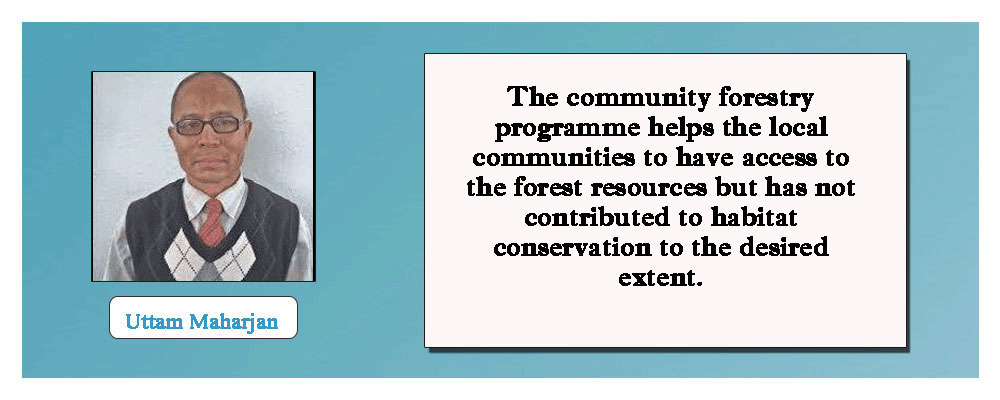- Saturday, 14 June 2025
Community Forestry Shows Sound Results
Forests are one of the important natural resources from economic as well as ecological viewpoints. In Nepal, about 45 per cent of the land is covered in forests. Two and a half decades ago, it was just 26 per cent. This has been possible owing mainly to the community forestry programme initiated by the government.
Before the start of the community forestry programme, the government had control over all the forests. The government was mulling over protecting the forests and forest resources. During the late 1970s, the government came up with a new programme to this end: the community forestry programme. In 1978, the Regulations of Panchayat Forests and Panchayat-protected Forest Rules came into effect, allowing the local governments to oversee and manage the forest areas selected for them. Likewise, in the 1990s, the Forest Act, 1993 came into effect. The Act accentuated decentralisation and allowed the local communities to manage the forests and utilise the forest resources. In fact, the Act played a significant role in advancing community forestry in the country.
Local participation
The community forest programme emphasises local participation. In fact, management of the forests is not possible through the sole efforts of the government. When there is active participation of the local communities with a sense of ownership, forests can be managed and protected satisfactorily. Under the programme, forests are managed through forest user groups. They have access to the forests and authority to use the forest resources such as firewood, timber and fodder up to the limit as prescribed by the government.
Around 25 per cent of national forests are managed by the forest user groups. There are around 23,000 such groups in the country. There are around 1.6 million households in the groups. The basic thrust of the community forestry programme is to empower the local communities and to spur environmental conservation. By using the forest resources, the local communities can benefit economically. As they have access to the forest resources, they can not only use them but also sell them. So they can benefit a lot. In fact, the community forestry programme aims at alleviating poverty and improving the livelihoods of the poor living in the rural areas.
The forest user groups are allowed to participate in the decision-making process. There are rich, medium and poor people in the forest user groups. All of them contribute equally to the management of forests. However, the rich have power and access to leaders. They have sway over forest management and governance. As a result, the poor and vulnerable groups such as women and low-caste people are often deprived of their decision-making rights. Therefore, it is essential to provide incentives for poor and vulnerable groups so as to enable them to participate in the decision-making process and actively engage in forest management and conservation.
The impact of the community forestry programme is already visible. Forests have covered even barren land. Biodiversity has also improved, to some extent. Biodiversity in the forested areas covered by the community forestry programme is better than in other forested areas. However, experts are of the view that the community forestry programme is concentrated on protecting forests and forest resources and providing economic benefits for the local communities. They argue that the community forestry programme has not paid adequate attention to habitats for wildlife. And biodiversity has not been maintained to the desired extent. For example, the monoculture of pines has given rise to green deserts that occur when pines block the sunlight from reaching the undergrowth.
Experts also suggest that wildlife management should be encapsulated in the community forestry programme. This will address problems such as human-wildlife conflicts and the creation of green deserts. The community forestry programme helps the local communities to have access to the forest resources but has not contributed to habitat conservation to the desired extent. Both forest and wildlife management should go hand in hand. This will help enrich biodiversity to a satisfactory extent.
The Department of Forests looks after forest cover, whereas the Department of National Parks and Wildlife Conservation cares for wild animals. There is no single entity that looks after both forest cover and wild animals. Although creating an authority concerned with both forest cover and wild animals is a policy matter, good coordination between the above two departments would yield positive results.
Enabling environment
The community forestry programme has reduced deforestation on the one hand, while it has promoted sustainable forestry, on the other. The programme has created an enabling environment for the local communities to manage the forests and enjoy economic advantages. At the same time, community development work has also benefited the local households, especially the marginalised ones. Community development work has helped them generate income. This is carried on through the funds generated by the forest user groups. Proceeds from the sale of forest products, membership fees and donations from various organisations make up such community funds. Community development work includes improvement of irrigation canals; construction of community buildings, schools, temples, etc.; drinking water schemes; improvement of foot trails; and so on. Community development work should be designed to benefit the poor.
The community forestry programme is a good initiative on the part of the government. But for the programme, the country would not have notched up such progress in forest management. The initiative has been acclaimed by the world community, too.
(Maharjan has been regularly writing on contemporary issues for this daily since 2000.)












-original-thumb.jpg)




